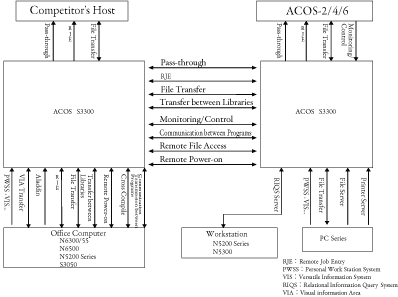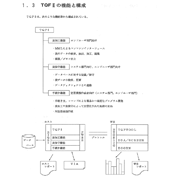NEC announced ACOS-2/EVP in July 1987 and started shipping it in November of that year.
ACOS-2/EVP served as the operating system for the ACOS System 3300 series, which fully adopted a CMOS full-customer LSI. It ensured expandability equivalent to that of large computers and provided new software as the core of integration between the computer and communication through creation of basic software equipped with a virtual memory on advanced architecture in which a dispatcher, memory protection and inter-program communication were presented in the form of firmware. In addition, it was also intended to provide functions that facilitated realization of a total system for increasing productivity in office operations.
Its major features included:
The OS supported a diagnosis-specific processor (DGP: Diagnostic Processor) even in the field of small computers. Equipped with a remote maintenance/diagnosis function that circuit-connected DGP with the remote maintenance center, it realized remote preventive maintenance and prompt response in the event of failure.
The OS provided an expanded network function that had the following features in order to respond to situations relating to networks, which were becoming larger and more complex, such as a vertically distributed network system consisting of a large computer and small computers, a horizontal network system consisting of multiple small computers, a system combining both, and a linkage between personal computers or computers of different types.
- Compliant with Expanded Network Architecture “DINA-XE”
The OS complied with the 7-layer model for the global-standard OSI and supported the industry-standard TCP/IP protocol to realize simple connection with competitors’ products. In addition, the company defined a function for communication between expanded networks (COM-XE) that realized peer-to-peer communication on an equal basis between programs and other functions as a standard protocol. - Function to Centrally Operate and Manage the Network
The OS was equipped with a monitoring function for observing the status of a list of systems connected via the network and the stationary/running status of each system, and a function to control execution on other systems such as command issuance, job issuance and remote report outputting to other systems.
Demand for development of computer systems for end users was increasing with the spread of workstations and personal computers into the end user sector. As a result, computer operation departments (mainly computer rooms) held many existing software programs, and NEC provided two development support systems as tools for solving this backlog problem:
- High-productivity language system “IDL II (Integrated Data oriented Language II)”
This system supported both the development support environment and the execution support environment, which raised the level of the programming language to that of a 4th generation language and maximized its effect, dramatically boosting the overall productivity of user operation development. It enabled automatic generation of a programming logic centered on programming data using patterns and visualized data design to support a series of processes from outline design to manufacturing/test process with a single view. - Software development support system “SOFPIA”
SOFPIA was an integrated software development environment that comprehensively supported a critical business system from design through maintenance. It offered a distributed development environment aimed at providing visual design support, standardizing development work, automating program production and performing integrated management and re-use of software assets.
These tools enabled the end user to achieve direct data processing by using EUF (end user facility):
- Database Service Partner “TQF II (Table oriented Query Facility II)”
This was an end-user function that could be widely used in standard clerical business processing and enabled search, processing (tabulation/classification), and report/graph outputting in formats appropriate to the task. - Decision-making Support System “Decision Support Partner II”
Decision Support Partner II was an end user tool whose purpose was to realize dynamic product sales strategies/tactics by analyzing data in three dimensions: item axis, departmental axis and temporal axis. It enabled the user to easily perform a statistical method and a time-series analysis method.




